Purportedly, eleven (11) gold bars made by the U.S. Mint in San Francisco were lost on the ship of the S.S. Brother Jonathan which sank off the coast of California on July 30, 1865.
The Bank of California once displayed five consecutive serial numbers (2178-2188) gold bars that came from this shipwreck — all of which were on loan from John J. Ford who had somehow acquired all of these in late 1970. This was all an elaborate ruse however. One bar remained with the collection, numbered 2181.

More information on the backstory that John Ford provided as well as the weak documentation can be found in The “Franklin Hoard” book by Karl Moulton on pages 607-617. The reality is that no gold bars or ingots were ever issued or released to any depositors at the U.S. Mint in San Francisco during the 1860s, period. (Reference: Dan Owens, Brasher Bulletin, Summer 2009, pg. 23).
Prior to 1933 and President Roosevelt’s gold regulations, the United States Mint and its branches would, for a fee, receive gold from private persons, assay and purify it, and return it in the form of bars or ingots bearing Mint stamps. In the 1860’s in San Francisco, such a practice seems to have been quite commonplace, and local firms, such as G.W. Bell and his successor, Rogers & Brown, openly competed with the San Francisco Mint for the public’s business. The bars and ingots so assayed were used for various diverse purposes, but primarily they represented a convenient way for a private individual to transport his or her savings or capital. Bars and ingots took up less space and were more portable than an equivalent face value of gold $10’s or even $20’s. Once the private person reached his or her destination, the bars or ingots could easily be converted into coin, since their values and fineness had the guarantee stamps of the United States Mint. For obvious reasons, very few such bars survive today.
In the Spring of 1865, a San Franciscan brought a substantial amount of money to the Mint and asked to have it converted into ingots. The Mint obliged, and paid over to the owner some eleven gold assay ingots, each of which was stamped with a serial number, the ingot’s value in dollars, its weight and fineness, and the Mint’s own validation stamp, dated 1865. John J. Ford, Jr., who has done more research on this subject than any other man alive today, believes that the original owner of the ingots was a San Francisco madam. Ford states that he has seen the Mint’s old records, the Assayer’s Register, 1854-1865, and the Register of Bar Warrants Paid, that list the names of depositors, and that there was just one owner’s name listed for ingots numbered 2178-2188. Further, Ford relates that the same woman’s name he saw on the San Francisco Mint’s registers also appears on the passenger manifest of the illfated side wheel steamer Brother Jonathan.
The Brother Jonathan was an 1,181 ton steamship built at the docks in the Williamsburg section of Brooklyn, New York. Her keel was laid in 1850 and when she was finished, she measured 220 feet 11 inches and was fitted to accommodate nearly 365 passengers, in addition to her crew. The Brother Jonathan was owned by Edward Mills, a typical entrepreneur of the times, a man not above shaving his services while raising his prices. Mills put his new ship to work along the New York to Panama passage, and the Brother Jonathan carried thousands of poor but hopeful steerage passengers on their long treks toward sunny California’s gold fields.
In 1852, Mills sold the Brother Jonathan to shipping mogul Commodore Cornelius Vanderbilt. Looking to increase his profit per trip, Vanderbilt immediately had the Brother Jonathan put into dry dock and refitted. Her old vertical steam engine, built by the Morgan Iron Works, was replaced by a newer engine capable of grinding out 400 horsepower. Vanderbilt ripped out the older accommodations inside, including the sumptuous staterooms for wealthy passengers, thereby doubling the Brother Jonathan’s passenger load, from 365 to nearly 750 souls. Once the Brother Jonathan had been refitted, into the kind of Vanderbilt steamship the eastern press was wont to call a “floating pigsty,” she was moved into Pacific waters, where Vanderbilt had her work the other leg of the Gold Rush trek, the San Francisco to Nicaragua route.
The Brother Jonathan plied the Pacific under Vanderbilt’s ownership until 1856, when Vanderbilt lost his monopoly on the Nicaraguan transit business. In 1857, Vanderbilt sold the Brother Jonathan to John T. Wright, who put her on the San Francisco to Portland, Seattle, and Vancouver route. In 1861, Wright sold the ship, and her new owners, the California Steam Navigation Company, refitted her once again, reducing her passenger capacity but
increasing her freight capability. One entire deck was removed, which may have inadvertently weakened her framing.
On July 28, 1865, the Brother Jonathan set sail from San Francisco for Vancouver, under the command of Captain Samuel J. DeWolf. She was overladen, so heavy with freight, that she settled deeply and the waterline rose dangerously high. Captain DeWolf protested the overloading, but the owners told him that if he did not sail with the ship they would find a replacement for him. Reluctantly, Captain DeWolf cast off, steaming through San Francisco harbor toward the Golden Gate and open ocean.
Aboard the Brother Jonathan was an illustrious passenger list and a fortune in gold. The new governor of Washington Territory, Anson C. Henry, was a passenger, as was General George Wright, on his way to take command at Fort Vancouver. A less illustrious passenger was a Mrs. Keenan, a San Francisco madam heading for Seattle with seven of her ladies. In the Brother Jonathan’s strongroom and safe was some $200,000, representing the payroll for the troops at Fort Vancouver. Joseph Lord, a Wells Fargo agent on board, is believed to have had about $250,000. Other passengers carried their own savings in gold in one form or another, including Mrs. Keenan, who carried with her eleven gold ingots totaling a little less than 21 pounds, all made for her at the San Francisco Mint.
Shortly after passing through the Golden Gate, the Brother Jonathan encountered heavy gales, which dogged her course for the next two days. The passage must have been extremely uncomfortable for both passengers and crew. On the afternoon of July 30, along the northern California coast off the beam of Crescent City, the Brother Jonathan met her doom. In the face of heavy seas, and unable to make headway against them because his ship was so heavily overloaded, Captain DeWolf decided to turn back to Crescent City and wait for the storm to end. The Brother Jonathan was successfully turned, and in clear conditions but under a strong gale wind she steamed south for nearly an hour. Then, at 1:50 in the afternoon, she struck a hidden rock, starting her deck planks and throwing the
passengers about like straws. The Captain ordered stop engine and tried to reverse his stricken vessel off the rocks, but after five minutes the Brother Jonathan seemed to shudder and horrified passengers watched as a long portion of her keel floated to the surface. Before anyone could react to this terrifying calamity, the Brother Jonathan ’s foremast crashed through the upper deck, penetrated the hull below, and through the gaping hole the water of the Pacific rushed in to seal the doomed vessel’s fate.
Only six lifeboats were launched, and five of them immediately foundered, drowning all aboard. The sixth, commanded by Third Mate James Patterson, successfully carried five women, three children, and ten other crewmen to shore. These were the only survivors from the 232 passengers and crew who made up the ship’s complement. The fact that more crewmen than passengers survived was harshly commented on in the press. As the vessel sank, San Francisco Bulletin correspondent James Nisbet calmly sat on deck, writing his will. Captain DeWolf went down with his ship, which took along with her a fortune in gold.
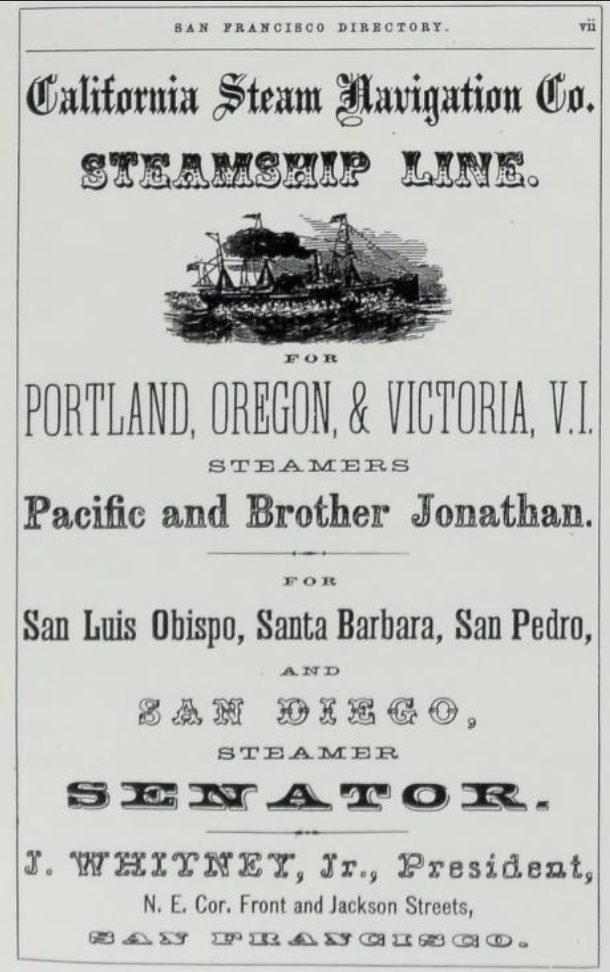
The San Francisco Directory for the year commencing October, 1864,” H.G. Langley, S.F., 1864.
For days afterwards, bodies washed ashore along the beach below Crescent City, including Nisbet’s, whose will was found in his jacket pocket. Local citizens established a special cemetery for the dead, which they named the Brother Jonathan Cemetery. Mrs. Keenan seems to have survived, but the NASCA cataloguer stated that the eleven Brother Jonathan ingots were recovered from a site between the wreck and the beach. Presumably, they went overboard from one of the capsized lifeboats. Attempts at salvage began almost immediately, but without success. A claim of discovery of the wreck in 1894 appears to have been a sham. There may have been an attempt in 1916 to salvage gold from the Brother Jonathan, and the Gibson sale cataloguer mentioned a Los Angeles based salvage group active about 1936. The Brother Jonathan gold bars known today may have been found in 1916, 1936, or even earlier. A new outfit, Deep Sea Research Inc., claims to have found the hull, and some artifacts have been retrieved, but thus far, no other gold.
$500, $24.24, 1865 Dated San Francisco Mint Gold Ingot From the Brother Jonathan
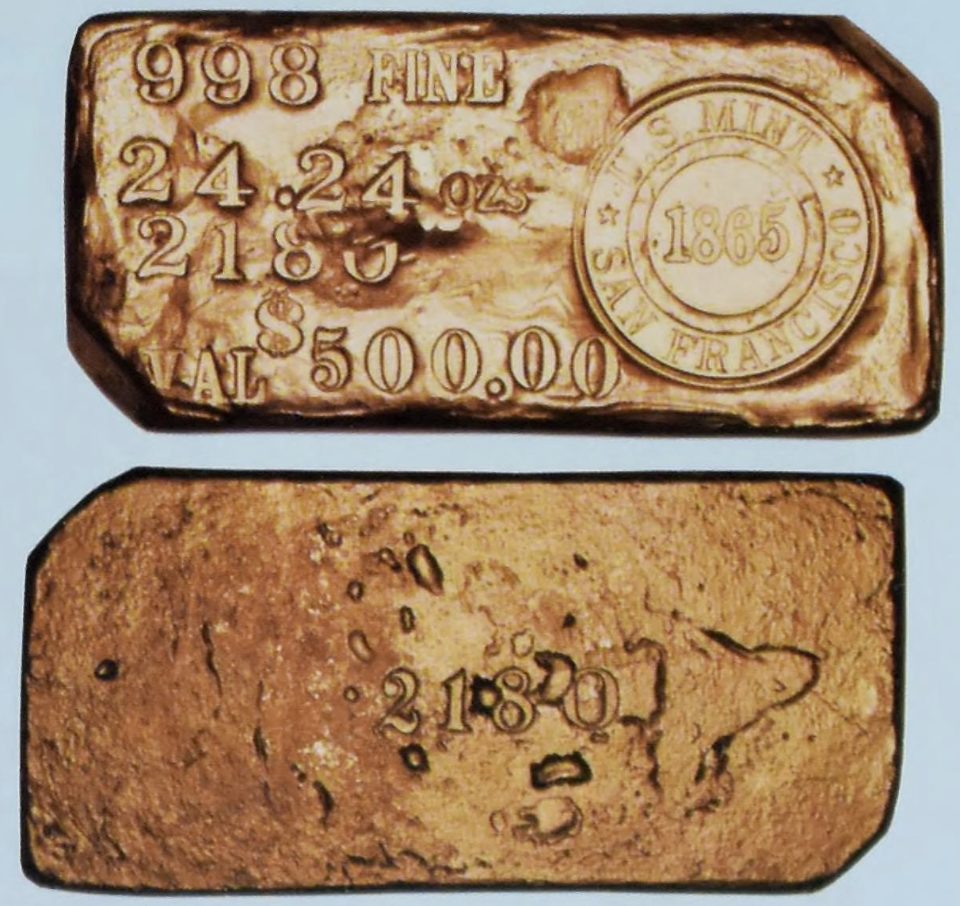
$500 U.S. Mint San Francisco gold ingot, dated 1865, weight 24.24 ounces, believed to have been carried as cargo by the Brother Jonathan,” a side-wheel steamer which was wrecked in the same year.
This immense gold ingot, as illustrated, bears the prepared circular stamp of the United States mint, San Francisco, 1865. The fineness is 998 thousandths, nearly pure gold; the weight is 24.24 ounces, the serial number is 2180, and the valuation is $500.00. The number 14 appears at the left and right ends of the bar, and on each of the two trimmed corners are to be found letters, E on one and M on the other.
The serial number 2180 is repeated on the back.
While most San Francisco Mint gold and silver bars are of odd denominations, depending upon the weight of the piece (which cannot be ascertained in advance when the ingot is being poured), in this instance the effort was made to produce a bar valued at an even amount $500. This was done by making the bar slightly heavier than required, then filing the corners until the desired weight was obtained. So that the filed corners would not be viewed as detracting from the weight stamped on the bar, the letters E and M were affixed indicating that this was done at the mint.
The condition is nearly as issued, with slightly matte surfaces due to action or salt water on the metal.
This ingot is one of eleven of varying values obtained in 1970. All have serial numbers, running consecutively from 2178 to 2188. John J. Ford Jr. has advised the cataloguer that in addition to No. 2180 (offered here) an example (2184) was sold by NASCA, April 30 1980and pieces bearing numbers 21 78, 2181, 2182, 2183, and 2185 formerly on display by The Bank of California in San Francisco, have been divided between the the bank and Ford, several having been returned to the Ford Collection, joining the three that the New York collectordealer initially retained. Ingot No. 2186 was sold as Lot 184 in Stack’s Gibson Sale, November 11, 1974, and realized $19,000. It had a stamped value of $308.73, thus lacking the monetary significance of this specimen.
While the exact history of these pieces is not known, it is believed that they were carried aboard the Brother Jonathan, which sank off the coast of California on July 30, 1865, after striking rocks. Mr. Ford theorizes that they could have been brought up from near the wreck by the Lund-Freese-Francisco expedition of 1916 or by another group which explored the area 20 years or so later.
John J. Ford. Jr. checking the records kept by the San Francisco Mint (Assayers Register 1854-1805) concludes that these were made in late spring of 1865, although the records are not complete in this regard.
It is believed that the cargo of the Brother Jonathan was valued at $300,000 to $500,000, including machinery for a woolen mill, mining apparatus for the Owyhee district in southeastern Oregon and Idaho two camels, and $200,000 in payroll for United States troops at Fort Vancouver, Washington. It is believed that the Wells Fargo agent on board, Joseph Lord, had with him about $250,000, and that close to $100,000 in jewelry and cash was in the purser’s safe. While there is no documentary evidence specifically linking this and the bars to the Brother Jonathan, the man from whom they were acquired had them in his family for many years and attributed them to that source.
The Brother Jonathan was one of the most prominent vessels engaging in the Pacific Coast trade. Built in New York, the wooden ship of 1,181 tons was made of locust, oak, and cedar. Her measurements were 220 feet 11 inches long, 36 feet wide, and 13 feet 10 inches deep. In an article, “Brother Jonathan: Pioneer Steamship of the Pacific Coast,” Alfred L. Lomax noted that accommodations for 350 passengers were provided, including 24 deluxe cabins. Power was provided by a vertical beam steam engine driving two paddle wheels, each 33 feet in’ diameter. When launched on November 2, 1850, the ship represented an investment of about $190,000.
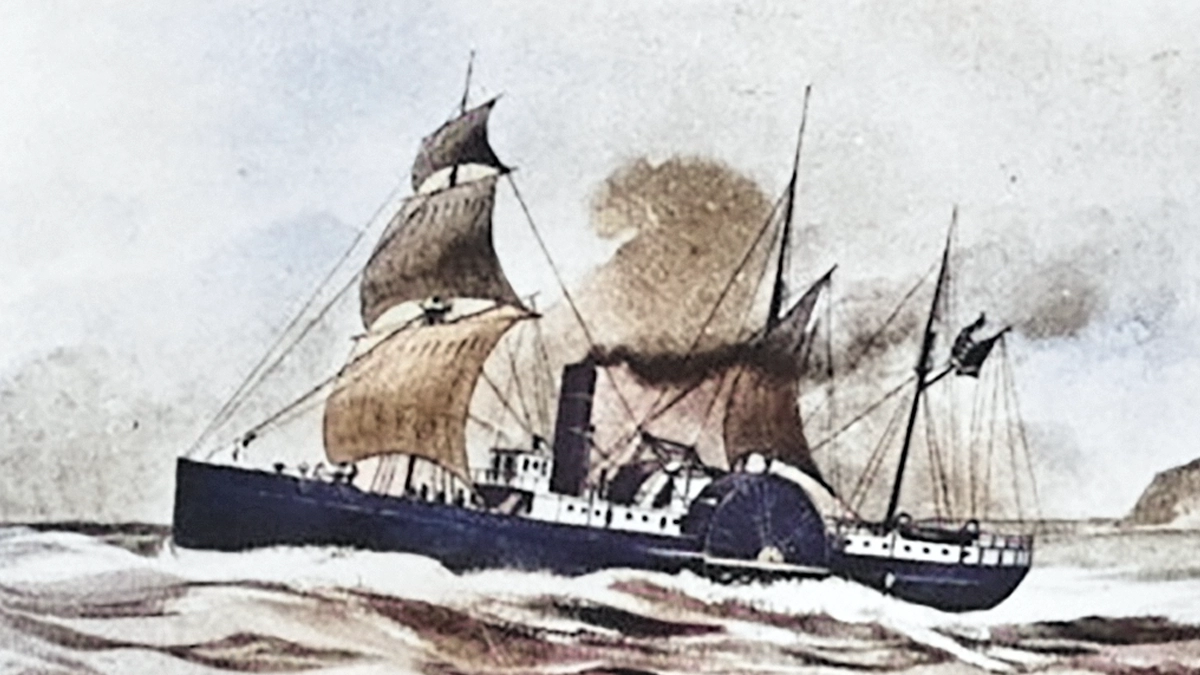
The vessel started operations early in 1851 on the New York to Panama route, carrying cargo and gold seekers. This schedule continued until March 1852 when Cornelius Vanderbilt acquired the ship, refitted it to accommodate 750 passengers, and put it on the San Francisco to Central America route. The era was one of transition from sails to steam, and after being refitted the Brother Jonathan was equipped with three masts and a 400 horsepower steam engine. Six life boats were provided for the passengers’ safety. After operating for slightly more than a half year, Vanderbilt sold the ship to the Accessory Transit Company, operators of the Nicaragua Steamship Company. Under this banner the vessel operated through 1857. Alfred L. Lomax wrote that “people liked the Brother Jonathan. According to one who had booked return passage, the ship presented so impressive an appearance when it was fully illuminated at night with its glittering, reflecting ornaments that it vied with the drawing-room of an imperial palace. Oilcloth of a bright and variegated pattern covered the floor. Crimson cushioned settees and chairs provided comfortable reading and writing facilities. The cuisine must have been excellent as meat was served regularly from freshly killed cattle, swine, sheep and poultry which the vessel carried and kept on ice . . . “
In 1857 the ship changed hands again, and the new owner used the Brother Jonathan in service between San Francisco and ports in Oregon, Washington, and British Columbia to the north. The name was changed to the Commodore. In 1858 she changed hands again and became the property of the California Steam Navigation Company. Renamed the Brother Jonathan the ship underwent repairs to strengthen its superstructure. In July 1860 she was again sold. In 1861 the ship was stripped down to its basic structure and extensively remodelled. The old dining room was eliminated in favor of a new one measuring 120 feet long on the upper deck. One deck was eliminated, resulting in two instead of three. In December 1861 the ship was advertised as being ready: “The new and splendid steamship Brother Jonathan built expressly for this route and with unequalled accommodations for passengers and freight, Samuel J. DeWolf, commander, will leave Pacific Street Wharf for the above ports [Portland and Victoria] on Thursday, December 19, 1861 …”
The most eventful voyage, the one that was to be her last, commenced on July 28, 1865. Overloaded, despite strong protest from the captain, the Brother Jonathan left San Francisco headed north. No sooner had she gone through the Golden Gate marking the entrance to San Francisco Bay than she ran into a fierce gale. Winds continued through July 30th, as the Brother Jonathan passed Crescent City on the coast of Northern California. Shortly after noon on the 30th, under clear skies in a sea whipped by the still-heavy winds, she ran onto rocks hidden beneath the surface. The concussion ripped a great hole in front of the engine room, causing the foremast to topple across the deck. Cannon shots were fired, alerting citizens on the nearby shore. In a scene which has been variously described from calm to confused, depending upon the report, six life boats were put into the water. Five were immediately swamped, and only one, commanded by James Patterson, the third mate, and carrying three children, five women, and ten crewmen, was able to reach shore, representing the only survivors from the 232 people comprising the crew and passengers.
The quartermaster, who was one of the survivors, later told his tale:
I took the helm at twelve o’clock. A northwest gale was blowing and we were four miles above Point St. George. The sea was running mountain high and the ship was not making headway. The captain thought it best to turn back to Crescent City and wait until the storm had ceased. He ordered the helm hard aport. I obeyed and it steadied her. I kept on due east. This was about 12:45. When we made Seal Rock the Captain said ‘southeast by south.’ It was clear where we were, but foggy and smoky inshore. We ran until 1:50 when she struck with great force, knocking the passengers down and starting the deck planks. The captain stopped and backed her, but we could not move the vessel an inch. She rolled about five minutes, then gave a tremendous thump and part of the keel came alongside.
By that time the wind and sea had slewed her around until her head came out of the sea and worked off a little. Then the foremast went through the bottom until the yard rested on the deck. Captain DeWolf ordered everyone to look to his own safety and said that he would do the best for all.
At the time the disaster represented the greatest loss of life of any shipwreck in the Pacific Coast area. For days afterward bodies, some wearing ineffective life jackets, floated ashore up and down the coast. Many of these were buried in the Brother Jonathan Cemetery established by the Crescent City community.
[03/1982] https://archive.org/details/henryhcliffordco1982bowe/page/n83/
As reported on page 615 of the “Franklin Hoard”, allegedly this ingot has been melted along with several others.
Other ingots from this series are documented below as best we know:
No 2159 – 21.81 oz – $444.0 – Bank of California
No 2180 – 24.24 oz – $500.00 – Bowers & Merena
No 2182 – 24.21 oz – $500.00 – Courtesy American Coin Treasures and Hoards
No 2184 – 16.54 oz – $340.20 – Stacks 6/11/1997, NASCA 04/1980
No 2186 – 15.01 oz – $308.73 – NASCA
Ingot No 2184:
California. 1865 $340.20 Gold San Francisco Assay Ingot. Essentially as issued, some superficial matte-like appearance due to sea water immersion. A rectangular 76.0 x 40.5 x 10.0mm. 16.54 oz. ingot bearing inscriptions on the front and two edges accomplished in logotype and individual punches and reading: 999 FINE / 16.54 OZS/ 2184 (i.e., the San Francisco Mint’s serial number) / VAL $340.20 on the left front, the right bearing the round logotype stamp of the United States Mint at San Francisco dated 1865. The letters “M” and “E” appear on the right and left corners, unexplained but possibly Mint assayer’s initials. Extremely rare as a type, Unique in this denomination. Only eleven such San Francisco Mint assay ingots were found in 1970. All were sequentially serial numbered, from 2178 through 2188. At one time, five of these ingots were in the possession of the Bank of California. In the 27 years since their discovery, only three have ever been offered for public auction competition: Serial No. 2186, sold by Stack’s in 1974 as part of the Gibson Collection; this specimen, last sold by NASCA in 1980; and Serial No. 2180, Henry Clifford’s, sold in 1982. Unfortunately, the Clifford ingot was melted after its sale and it no longer exists.
6 oz $124.00 1915 San Francisco Mint – Assay P.P. EXP
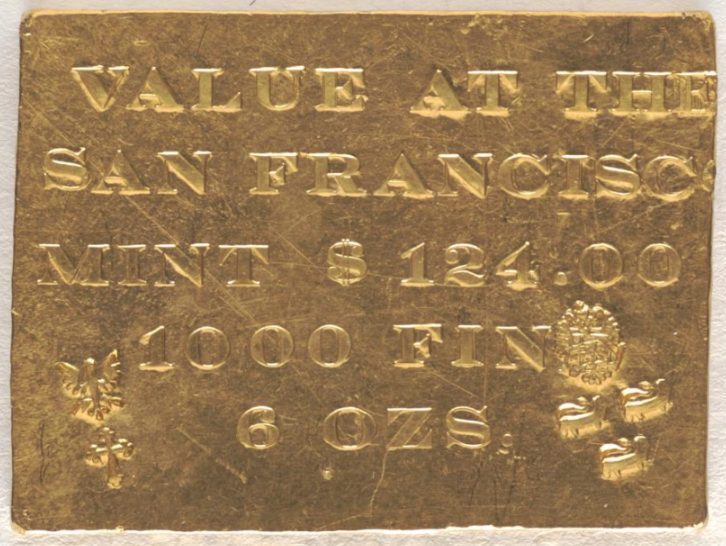
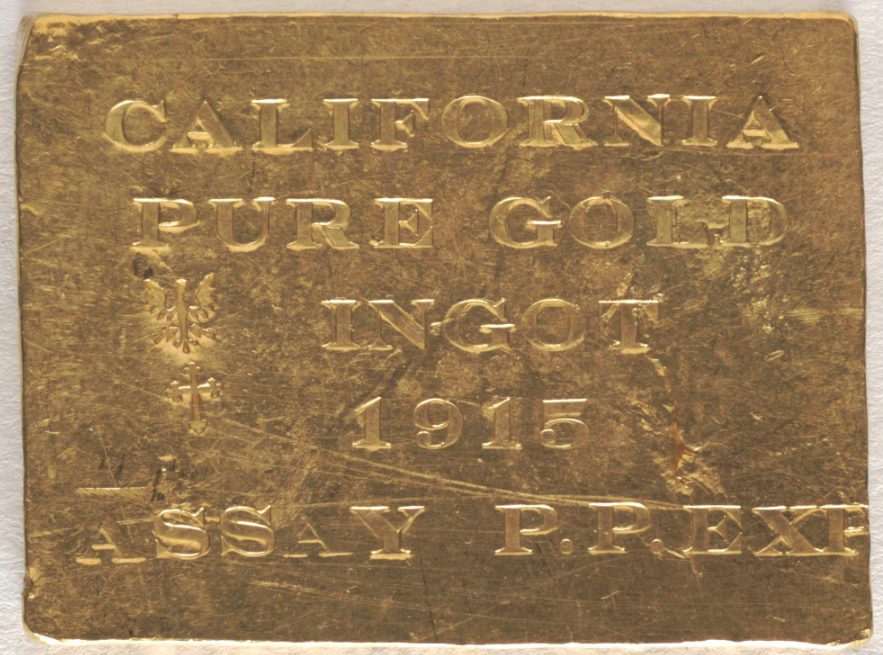
Measures: 3.3 cm x 4.4 cm x .7 cm; 1 5/16 in x 1 23/32 in x 9/32 in
Another less known ingot is the $124.00 gold bar at the Smithsonian Institution. Very little is known about this ingot except that it came from the same (in)famous collection through Josiah K. Lilly Jr. Unknown at this time what “P. P. EXP” are supposed to represent.
See: https://americanhistory.si.edu/collections/nmah_1103621
